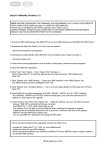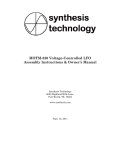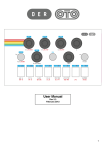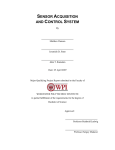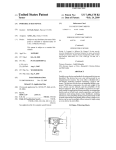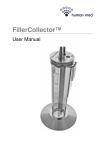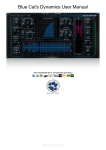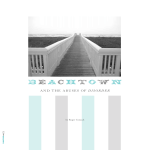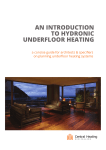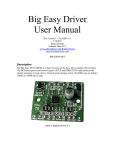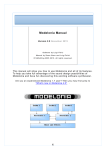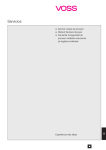Download biscuit_user_manuel_en
Transcript
$2)6% .!+%$ "90!33 $2%33%$ "2!). #,/#+ 4!0 1 & & &),4%2 &2%1 & 7!6% $%,!9 0)4#( 34%0 BISCUIT user manual Copyright ©2009 OTO MACHINES SARL. All rights reserved. No part of this manual may be reproduced in any form without the written permission of OTO MACHINES SARL. Product features, specifications, availability and informations in this manual are subject to change without notice. www.otomachines.com 1 Safety warnings and recommendations Warning on epilepsy Do not eat Biscuit. Before using BISCUIT, make sure you read all the instructions below, and the User Manual. BISCUIT should be connected to a power supply only of the type described in this manual. The included AC adaptor has some openings on its enclosure for cooling purpose. Do not obstruct these openings, or place things on the top of the AC adaptor which could prevent normal cooling. If your BISCUIT is unused for a long period of time, disconnect the AC adaptor from the outlet. BISCUIT, in combination with an external amplification system or headphones, may generate a high sound level, which could potentially damage your ears. Do not operate BISCUIT for a long period of time at a high volume level. It’s safer to keep reasonable levels and start with low volume. Do not expose BISCUIT and its AC adaptor to rain, moisture, dust, sand or dirt. Do not pour liquids into BISCUIT. Never use or store BISCUIT near water, for example sea, swimming pool, bathtub, kitchen or bathroom sink. BISCUIT should be located away from high temperatures (> 35 degrees C), for example direct sunlight in an enclosed vehicle, radiators, heat registers, stoves or other heat sources. Only clean BISCUIT with a soft, dry cloth. Do not apply any liquids or alcohol. Do not apply excessive vibration forces to BISCUIT, do not drop it and always transport it in its original packaging or in shock-absorbent material. Never climb on top of, nor place heavy objects on BISCUIT. A very small percentage of individuals may experience epileptic seizures or blackouts when exposed to certain light patterns or flashing lights. If you have an epileptic condition or have had seizures of any kind, consult your physician before using Biscuit. Warranty BISCUIT is sold with one year full warranty. This warranty covers all malfunctions that may occur from normal use, and does not cover damage due to abuse, faulty connections or operation under other than specified conditions. Warranty is void when serial number is unreadable, when the device is repaired by unauthorized persons, opened, or tampered with in any way, or if the product was not sold to the end-user through an authorized dealer or the OTO MACHINES website. This warranty is limited to replacement or repair of the product. The unit can only be returned for repair after agreement from OTO Machines. Customer covers shipping cost of faulty BISCUIT to OTO Machines and OTO Machines covers shipping cost back to customer. Disposal The trash can symbol indicates that your product must be disposed of properly according to local laws and regulations. Table of contents 1 Presentation page 5 User Interface/ Front Panel Rear Panel Example connections Diagram Set the Input Level page page page page page 6 8 9 11 11 4.1 4.2 4.3 4.4 4.5 2 Biscuiting page 12 5 3 Effects page 13 Waveshaper Delay Pitch Shifter Step Filter page page page page 5.1 5.2 5.3 5.4 1.1 1.2 1.3 1.4 1.5 3.1 3.2 3.3 3.4 14 16 19 20 4 6 Presets page 24 Saving a preset Recalling a preset Snapshots Potentiometers position Factory presets page page page page page Midi page 28 Midi Channel Midi Filters Presets Dump Program Change page page page page Specifications page 36 24 25 26 27 27 29 30 31 33 BISCUIT has been tested to comply with the 2004/108/EC EMC Directive. Some parts of BISCUIT are fragile (such as the housing and some electronic components), so dropping it might damage your BISCUIT. Repair work resulting from dropped BISCUIT is not covered by the normal warranty of the product. Do not leave small children alone with BISCUIT, and do not let them use BISCUIT unless they are capable of following all the rules for the safe operation of BISCUIT. Do not open (or modify in any way) BISCUIT or its AC adaptor. There are no user serviceable parts inside. Refer all servicing to qualified personnel only. If you think your BISCUIT needs repair, you can send us an e-mail at : [email protected]. 2 3 1 PRESENTATION Thank you for choosing the BISCUIT ! BISCUIT is a stereo effects processor. Thanks to a subtle blend of 8-bit digital and analog processing, BISCUIT is able to create a wide range of sounds. It goes from 8-bit character and lo-fi digital artefacts to numeric distortions. BISCUIT is very useful to add depth and texture to any kind of electronic sound. It works best with synthesizers (digital or analog), bassline, drum machines, loops, samplers or computers, but you can use it with any other source. BISCUIT is basically an enhanced bit depth and sample-rate reducer, known as “bitcrusher”, followed by an analog filter and a simple mixing section (dry/wet). It also offers other features like removing or inverting each of the 8 bits, changing the sample rate from 250Hz to 30kHz, or adding one of the four effects (waveshaper, delay, pitch shifter and step filter). You can save the complete BISCUIT settings (pots and switches) in 16 presets. A SysEx dump function lets you save and recall as many presets as you like on your computer. Features • Stereo inputs and outputs • Input gain from -c to 15 dB with diode clipping • Real 8-bit Analog to Digital and Digital to Analog converters • True analog multimode filter with resonance control • Variable sample clock from 250 Hz to 30 kHz • Unique capability of muting and inverting each of the 8 bits • FX section: Waveshaper, Delay, Pitch Shifter and Step Filter • Separate level control of dry and 8-bit signals • 16 presets • MIDI compatible • True relay bypass • Rugged metallic Neutrik® connectors Biscuit is MIDI compatible. 4 5 1.1 USER INTERFACE/ Front Panel 01 01 USER INTERFACE/ 1.1 Front Panel (FIG1) 1 DRIVE : Input gain (from -c to +15 dB) placed before the AD conversion. A diode clipper protects the converters 2 NAKED : Dry signal level (from -c to 0 dB) 3 DRESSED : 8-bit signal level (from -c to 0 dB) 4 Q : Filter Resonance $2)6% 5 FILTER : Filter type. Switch colour indicates which type of filter is selected : Green is for Low-pass, Yellow for Band-pass and Orange for Hi-pass 6 FREQ : Filter cutoff frequency (from 20 Hz to 15kHz) $2%33%$ 1 7 BRAIN : When BRAIN is off, the switches 1 to 8 are used for Biscuiting (cf Chap. 2). When BRAIN is Blue, the switches 1 to 8 are used for selecting FXs and parameters. This switch is also used for recalling and saving Presets and to access the MIDI section 8 CLOCK : Sample Clock Frequency (from 250 Hz to 30 kHz). This pot is also used in the FX section to set parameters .!+%$ "90!33 "2!). #,/#+ &),4%2 &2%1 9 BYPASS : True relay bypass. When the switch lights up green, BISCUIT is active. It turns orange when input signal is strong. When its light is off, BISCUIT is inactive and input signal is directly routed to output jacks, with no electronics in between 10 - 1 to 8 : These switches have 2 main functions : muting or inverting the 8 bits and selecting FX type and parameters. They are also used for presets, MIDI section and snapshots 4!0 6 & & & 7!6% $%,!9 0)4#( 34%0 7 1.2 REAR PANEL 03 IN L/MONO : Left or Mono input. Unbalanced 1/4” jack IN R : Right input. Unbalanced 1/4” jack OUT L : Left output. Unbalanced 1/4” jack OUT R : Right output. Unbalanced 1/4” jack MIDI IN : MIDI input MIDI OUT : MIDI output AC ADAPTOR INPUT : Only use a 9 volts AC adaptor, 500 mA minimum with a 2.1mm plug POWER SWITCH #/-054%2 $25--!#().% ,).%).0543 ). /542 /54 ). 6!# /./&& ).,-/./ ).2 /54, /542 /54 6!# /./&& 02 -/.)4/230%!+%23 /54, -)8%2 ).2 -)$)).4%2&!#% ).,-/./ 1 2 3 4 5 6 7 8 1.3 EXAMPLE CONNECTIONS 02 !#!$!04%2 39.4(%3):%2 8 9 1.4 DIAGRAM 04 ")4 !$ #/.6%24%2 #,/#+ ")4 $! #/.6%24%2 1.5 SET THE INPUT LEVEL &),4%2 ). ,-/./ $2%33%$ $2)6% &2%1 -)#2/ #/.42/,,%2 After changing gain by using the DRIVE pot, the sound is converted into an 8-bit digital signal. The sample clock can be adjusted from 250 Hz to 30 kHz. By lowering the sampling frequency aliasing effects are produced. You can mute or invert each of the 8 bits using the 8 rectangular switches. The sound is then converted into an analog signal and goes to a multimode filter to be mixed with the direct signal (via the NAKED and the DRESSED pots). .!+%$ -5,4)-/$% &),4%2 04 /54 ,%&4 The DRIVE pot adjusts the signal level at the BISCUIT input. Turn this pot counterclockwise for strong input signals, and clockwise for weaker signals. The BYPASS switch lights up green when BISCUIT is active, and for no or moderate input signal. The light goes from green to orange to indicate a strong signal. 1 53%2).4%2&!#% 37)4#(%3,%$3 In normal use, the BYPASS switch should change to orange quite often. If the BYPASS switch lights up orange when the DRIVE pot is below its 9 o’clock position, it means that your input signal is too strong (loud line-level for example). Reduce the source level to obtain a better DRIVE range and to avoid clipping. -)$)) $2)6% &2%1 1 $2%33%$ ")4 !$ #/.6%24%2 ). 2)'(4 10 ")4 $! #/.6%24%2 -5,4)-/$% &),4%2 &),4%2 .!+%$ /54 2)'(4 11 05 !,,")43/. ")4).6%24%$ ")4-54%$ 06 ")4!#4)6% 7()4% ")4).6%24%$ 2%$ ")4-54%$ /&& 07 08 ",5% 34%0 2. BISCUITING 34%0 34%0 &)' BISCUIT’s main function is to modify the 8 bits status with the 8 rectangular switches. Depending on the modifications applied (bits inverted, muted, the bit number) the conversion will reproduce a sound faithful to the original or totally deconstructed. and is often used for bit reduction or for adding noise to signal. BISCUIT has a level compensation system. However depending on the input signal, distortion can still be very loud. Keep the « DRESSED » pot in check to avoid hearing problems. Muting or inverting some of the bits can generate strong distortions, with an intense digital character. 05 Shortcuts When you press the « 1 » and « 2 » switches simultaneously, the 8 bits are in their normal state (they’re all white) When you press the « 1 » and « 3 » switches simultaneously, the 8 bits are all inverted (they’re all red) When you press the « 1 » and « 4 » switches simultaneously, the 8 bits are off You’re in Biscuiting mode when the BRAIN switch is off. The colour of the 8 rectangular switches shows us the different bit status. To modify their state, just press any rectangular switch. 06 NB : High order bits (6,7,8) are the most « powerful » bits. Changing their state produces stronger distortion than changing the state of low order bits (1, 2, 3). Changing « 1, 2, 3 » bits produces subtle effects 12 "2!). "2!). & 7!6% $%,!9 0)4#( 34%0 7!6% $%,!9 0)4#( 34%0 3. EFFECTS You can add one of the four following effects to your 8-bit modifications : WAVESHAPER, PITCH SHIFTER, DELAY and STEP FILTER. BISCUIT is a dual mono effect (there are two « BISCUIT » in the box). WAVESHAPER and STEP FILTER are stereo, DELAY and PITCH SHIFTER are mono. Direct signal (NAKED) is always stereo. To activate and set effects, press the BRAIN switch which lights up blue. NB : You can save your 8 bits configuration in one of the 8 memory slots called “Snapshot” (cf Chap. 4). & Press one of the four switches on the right to activate or deactivate one of the four effects. 08 You can only have one effect activated at a time. The corresponding switch lights up red to show you which effect is currently selected. The effect name is written underneath the switches. Depending on the chosen effect, you have different parameters to set. These parameters are accessible through the « - / F1 », « + / F2 », « F3 » switches and the CLOCK pot (acting as « DATA ENTRY » in this case). 07 13 09 10 02%33/.%/& 4()337)4#(4/ 3%,%#4 7!6%3(!0%2490% 2 3 4 6 7 8 "2!). 4!0 & & & 7!6% $%,!9 0)4#( 34%0 3.1 WAVESHAPER A waveshaper is a device that modifies the signal waveform using digital processing. BISCUIT offers you 8 types of waveshaping. These treatments can create distortions (type 1 to 5) very different from Biscuiting (cf chap 2), or even generate a synthesizer waveform (type 6 to 8). Only the « - / F1 » and « + / F2 » switches are used in this effect. They allow you to select one of the 8 types of waveshaping. The switch lit up white indicates the current selection. 09 The CLOCK pot acts as usual (changing the sampling frequency), except for the last 3 waveshapers (oscillators) where CLOCK sets the filter attack. 14 1 5 WAVESHAPER TYPES 10 1/ Rectifying : The negative parts of the signal are inverted and become positive. This waveshaper creates an octave up effect, similar to a fuzz octave pedal. 2/ Alternate rectifying : Only the positive parts of the signal are used, and one of two are taken off. This waveshaper creates a distorted octave down effect. 3/ Bat Fuzz : Beyond a certain threshold, sound is inverted, as in a mirror. 4/ Biscuit : This create a fifth down effect with some crunchy saturation added. 5/ Swap : The 1 to 4 bits are swapped with the 5 to 8 bits. This distortion is pretty radical and full of high harmonics. It may be close to white noise depending on the signal level. Try to lower the DRIVE pot to get different sound colours. The 6, 7 and 8 waveshapers are little synthesizers. They generate a waveform that tracks input signal frequency. These 3 waveshapers work best on bass synth sounds but can lead to stunning results on other sources. The DRIVE pot works at the same time on the sensitivity of the filter attack and on the detection of input signal to generate the waveform. To allow the oscillator to work properly, BISCUIT needs a certain amount of input signal. Thus the BYPASS switch should often light up orange. Adjust the DRIVE pot to obtain a stable sound and a well-defined attack. The CLOCK pot sets the level of the filter attack. When the incoming signal attacks are not detached (legato), the filter attack will not be triggered. Play staccato or play on a keyboard (connected to MIDI in) to trigger attacks. Check that the NOTE ON function in the MIDI menu is on.(cf Chap5) 15 11 12 452.4(%#,/#+0/4 4/#(!.'%35"$)6)3)/. ,)4507()4% & & & 7!6% "2!). 452.4(%#,/#+0/4 4/#(!.'%&%%$"!#+ ,)4507()4% "2!). #,/#+ 4!0 13 4!0 $%,!9 & & 7!6% $%,!9 0)4#( & "2!). 452.4(%#,/#+0/4 4/#(!.'%$%,!94)-% 34%0 4!0 & & & 7!6% $%,!9 0)4#( 34%0 3.2 DELAY 6/ Sawtooth wave oscillator at input signal frequency. 7/ Sawtooth wave oscillator an octave below the input signal frequency. 8/ Square wave oscillator an octave below the input signal frequency. NB : Even if you can use both Biscuiting and Waveshapers at the same time, the different waveform modifications it creates can sometimes conflict, resulting in a very low sound level. In order to have a better understanding of the Waveshapers, start using them with the 8 bits in their normal state (the 8 switches lit up white). 16 This is an 8-bit mono delay. Only the left input is used. The delay output is sent on both left and right outputs and can be mixed with the direct stereo signal, via the DRESSED and NAKED pots. The « TAP », « - / F1 », « + / F2 », « F3 » switches are used to set delay parameters: TAP : Tap this switch in rhythm to set the delay time. The switch will flash in rhythm. If BISCUIT receives a MIDI BEAT CLOCK message, the « TAP » switch will be inactive and the delay time will follow the MIDI tempo (unless you have deactivated the MIDI CLOCK RX function in the MIDI menu. Chap 5). F1 : subdivisions : 11 When this switch lights up red, the CLOCK pot allows you to select the tempo subdivision. You can choose between six different subdivisions : • Quarter Note (switch 1 lights up white) • Dotted Quarter Note (switch 2 lights up white) • Eighth (switch 3 lights up white) • Dotted Eighth (switch 4 lights up white) • Sixteenth (switch 5 lights up white) • Dotted Sixteenth (switch 6 lights up white) F2 : Feedback : When this switch lights up red, the CLOCK pot sets the delay reinjection level: from 0 (switch 1 lights up white) to 100% (switch 8 lights up white). 12 F3 : Free Clock : When this switch lights up red, the TAP TEMPO or the MIDI BEAT CLOCK are inactive. The delay time is now set by the CLOCK pot. 13 If you press the « F3 » switch again (it turns off), delay will go back to TAP TEMPO or the MIDI BEAT CLOCK. 17 &2%%#,/#+0/3)4)/. )33!6%$ 14 452.4(%#,/#+0/4 4/#(!.'%&%%$"!#+ 7(%.9/5!2%). &2%%#,/#+-/$% 4!0 15 "2!). '/"!#+4/&2%% #,/#+3%44).' "2!). & & 7!6% $%,!9 0)4#( & 16 #,/#+0/47),, "%#/-%!#4)6%7(%. )42%!#(%34(%3!6%$ &2%%#,/#+6!,5% 34%0 4!0 & & & "2!). 452.4(%#,/#+0/4 4/#(!.'%0)4#( ,)4507()4% 7!6% $%,!9 0)4#( 34%0 /#4 $/7. /#4 $/7. 4( $/7. $%45.% -).2$ 50 -!* 2$ 50 4( 50 /#4 50 4!0 & & & 7!6% $%,!9 0)4#( 34%0 3.3 PITCH SHIFTER You can still set your delay feedback when the « F3 » switch (Freeclock) is on. Press the « +/F2 » (Feedback) switch (that flashes red) and set your delay feedback by moving the CLOCK pot (cf +/F2 : FEEDBACK). The « F3 » switch still lights up red and has saved the last freeclock setting. 14 By pressing the « F2 » switch again you go back to the freeclock function. The CLOCK pot’s physical position may very well be different than the previous freeclock setting, since you moved it to set the delay feedback. 15 18 To prevent a sudden jump of the delay time, the CLOCK pot will not be active until it reaches the previous value. The BYPASS switch will briefly turn blue to indicate this. An « Old School » 8-bit transposition is applied to the signal. Only the left input is used, the pitch shifter output is sent on both left and right outputs and can be mixed with the direct signal. NB : BISCUIT modifies the delay time by changing its sampling frequency. The longer the delay (slow tempo and dotted quarter note), the lower the sampling frequency. Some aliasing may appear when the input signal contains H.F. harmonics. The 1 to 4 switches are inactive in this mode. Only the CLOCK pot is used in this effect. It selects the transposition value, indicated by one of the 8 switches lit up white. 16 1/ 2 Octaves down (C 1) 2/ 1 Octave down (C 2) 3/ 1 Fifth down (F 2) 4/ Detune : signal is transposed by some hundredths of a semitone (C 3) 5/ 1 Minor third up (D #3) 6/ 1 Major third up (E 3) 7/ 1 Fifth up (G 3) 8/ 1 Octave up (C 4) NB : You can also select the transposition value by using a MIDI keyboard. The notes are written between parentheses. 19 17 18 "2!). 3%,%#44(%34%0 4/72)4% ,)4507()4% 4!0 & & & 7!6% 72)4%4(%#54/&& &2%15%.#9 $%,!9 0)4#( 34%0 19 02%334(%37)4#( 4/3%,%#4 4(%0,!9-/$% ,)4507()4% &/27!2$ !,4%2.!4% 2!.$/- 4!0 & & & 7!6% "2!). 452.4(%#,/#+0/4 4/#(!.'%30%%$ ,)4507()4% "2!). $%,!9 0)4#( 34%0 4!0 & & X X X X X & 7!6% $%,!9 0)4#( 34%0 3.4 STEP FILTER STEP FILTER allows you to memorize 8 positions (steps) of the FREQ pot and to read these different steps one after the other. Many settings of Play Mode, Speed and Number of steps are available. The STEP FILTER speed depends on TAP TEMPO or MIDI BEAT CLOCK. A MIDI START message will lock the first step to the beginning of the first bar. TAP : Tap this switch in rhythm to set the STEP FILTER speed. The switch will flash in rhythm. If BISCUIT receives a MIDI BEAT CLOCK message, the « TAP » switch will be inactive and the STEP FILTER speed will follow the MIDI tempo (Unless you have deactivated the MIDI CLOCK RX function in the MIDI menu. Cf Chap 5). The « TAP », « - / F1 », « + / F2 », « F3 » switches are used to set the STEP FILTER parameters. When the « - / F1 », « + / F2 » and « F3 » switches are off, the CLOCK pot acts as usual (modification of the sampling frequency). F1 : WRITE : When this switch lights up red, you can record any position of the FREQ pot (Filter cutoff frequency) in one of the 8 steps. The CLOCK pot allows you to choose one of the 8 steps (that lights up white). To record a cutoff frequency value, you just have to move the FREQ pot to the desired 20 position. If you don’t touch the FREQ pot, the previous value will not be erased. 17 F2 : RUN : When this switch lights up red, you can choose one of the 3 play modes and select one of the 5 speeds. Press the « TAP » switch to select one of the 3 play modes, indicated by one of the 3 first switches lit up white. 18 2/ Alternate : The steps play from left to right. When the last step is reached (depending on the NUMBER parameter), the steps play in reverse, from right to left. 3/ Random : The steps play at random. Move the CLOCK pot to select one of the 5 speeds, indicated by one of the last 5 switches lit up white. 19 1/ Forward : The steps play from left to right, looping back to step 1 when the last step is reached (depending on the NUMBER parameter). 21 20 452.4(%#,/#+0/4 4/#(!.'%.5-"%2 /&34%03 ,)4507()4% "2!). Summary of the fx parameters : WAVESHAPER (1) 4!0 & & & 7!6% $%,!9 4/ Speed x1 : The STEP FILTER goes at the TAP TEMPO or MIDI BEAT CLOCK Speed. TAP -/F1 +/F2 F3 NOT USED - + NOT USED SELECT ONE OF THE 8 WAVESHAPER SELECT ONE OF THE 8 WAVESHAPER DIVISION (2) FEEDBACK (2) FREE CLOCK (2) FROM 0 TO 100% DELAY TIME 0)4#( 34%0 7/ Speed x8 : The STEP FILTER goes eight times as fast as the TAP TEMPO or MIDI BEAT CLOCK Speed. 5/ Speed x2 : The STEP FILTER goes twice as fast as the TAP TEMPO or MIDI BEAT CLOCK Speed. 8/ Speed x24 : The STEP FILTER goes 24 times as fast as the TAP TEMPO or MIDI BEAT CLOCK Speed. 6/ Speed x4 : The STEP FILTER goes four times as fast as the TAP TEMPO or MIDI BEAT CLOCK Speed. F3 : NUMBER : When the switch lit up red, you can choose the number of steps with the CLOCK pot. One of the 2, 3, 4, 6, 8 switches lit up white indicating the current number of steps. 20 22 21 DELAY TAP TEMPO PITCH SHIFTER (3) NOT USED NOT USED NOT USED NOT USED STEP FILTER TAP TEMPO WRITE RUN NUMBER (2) & SELECT THE PLAY MODE SELECT THE STEP WITH CLOCK SPEED (2) : x1 x2 x4 x8 or x24 2, 3, 4, 6 or 8 STEPS WHEN F2 IS LIT UP MOVE FREQ TO WRITE PLAY MODE (hit TAP) : fwd, alt, random NB 1 : The CLOCK pot sets the filter attack for the WAVE number 6, 7 and 8 (oscillators). NB 2 : Use the CLOCK pot to modify the parameters. NB 3 : The CLOCK pot select the pitch : - 2 oct, - 1 oct, - 5th, detune, + 3rd m, + 3rd M, + 5th, + 1 oct. 23 3%# 22 "2!). & & 23 02%33 (/,$ 7!6% $%,!9 0)4#( &),4%2 02%33"2!).4/ 3%,%#402%3%43 4/ 24 "2!). & 34%0 4. PRESETS You can save all the BISCUIT functions (pots position, switches, filter, bypass, fx) in one of the 16 presets. 4.1 SAVING A PRESET While pressing the BRAIN switch, press the FILTER switch. Keep pressing the BRAIN switch for 2 seconds. 22 The switches 1 to 8 flash red. Press one of the switches 1 to 8, all the Biscuit functions will be saved in the corresponding preset. 24 "2!). & 02%33 (/,$ 7!6% $%,!9 0)4#( &),4%2 34%0 4.2 RECALLING A PRESET Switches will then revert to the display of the 8 bits status. To save the presets 9 to 16, do the same as explained above. When the 8 switches flash red, press the BRAIN switch again. The BRAIN switch turns blue. 23 You can then save to one of the presets 9 to 16 by pressing one of the switches 1 to 8. While pressing the BRAIN switch, press the FILTER switch. 24 The switches 1 to 8 flash white. Press one of the switches 1 to 8 to recall the desired preset. Switches stop flashing. The selected switch will light up for 2 seconds. Switches then revert to the display of the 8 bits status. To exit the « saving a preset » or « recalling a preset » mode, press again the FILTER switch while pressing the BRAIN switch, or wait for 10 seconds. BISCUIT will revert to its regular state. To recall one of the presets 9 to 16, do the same as explained above. When the 8 switches are flashing white, press the BRAIN switch again. The BRAIN switch turns blue. 23 You can now select one of the presets 9 to 16, by pressing the switches 1 to 8. 25 25 26 3%# (/,$ 02%33 4!0 & & 27 "2!). & (/,$ 02%33 7!6% 4!0 & & "2!). & 7!6% 4.3 SNAPSHOTS You can save your 8 bits configuration in one of the 8 memory slots called « Snapshot ». Snapshots only save the 8 bits status. If you want to save all the BISCUIT functions (pots, effects and parameters), use the Presets (cf Chap 4). The 8 snapshots are independent from the presets. SAVING A SNAPSHOT While pressing the BRAIN switch, press the « 1 TAP » switch. 26 3%# 28 1 2 3 4 LOVE 8 OLD COMPUTER BITS BENDING DARK SIDE 5 6 7 8 NOISE ADDER STEP FAZOR RUSTY JAM DELAY DELay delay 9 10 11 12 BROKEN DELAY CONTINENTAL NAUTILUS MIDLINE 13 14 15 16 DETUNE BECQUEREL DIRTY LEAD DIGITAL DUCK "2!). & & 02%33 (/,$ 7!6% $%,!9 0)4#( &),4%2 34%0 4.4 POTENTIOMETERS POSITION 4.5 FACTORY PRESETS Keep pressing the BRAIN switch for 2 seconds. 25 The switches 1 to 8 flash red. You can now press one of the switches 1 to 8 to save the 8 bits status in the corresponding snapshot. The switches revert to their regular states. Once you recall a preset, the physical position of a pot may not be the same as in the preset. To prevent a sudden jump of volume after recalling a preset, the preset value will reach the pot value in a smooth fade of 1 second. The 16 BISCUIT presets contain factory settings called the factory presets. 27 RECALLING A SNAPSHOT While pressing the BRAIN switch, press the « 1 TAP » switch. 26 The switches 1 to 8 flash white. You can now press one of the switches 1 to 8 to recall the corresponding snapshot. The switches stop flashing and revert to their regular states. If you want to know the original value of a pot in the preset you just recalled, keep pressing the BRAIN switch and move this pot. The BYPASS switch turns blue when the pot reaches the preset value. By saving your own presets, you will erase these factory presets. You can still recall these 16 factory presets whenever you want. While pressing the BRAIN switch, press the FILTER switch. Keep pressing the BRAIN switch for 4 seconds. 28 The switches 1 to 8 will first flash red after 2 seconds, and will flash pink 2 seconds later. Press one of the switches 1 to 8 to recall the desired factory preset. Switches stop flashing. Only the selected switch stays alight for 2 seconds. 27 29 02%33 30 "90!33 4!0 (/,$ & & "90!33 "2!). & 7!6% 31 $%,!9 "2!). #(!..%, &),4%23 $5-0 4!0 & & & 7!6% Switches then revert to their regular function. 5. MIDI To recall one of the factory presets 9 to 16, do the same as explained above. When the 8 switches are flashing pink, press the BRAIN switch again. The BRAIN switch turns blue. You can now select one of the factory presets 9 to 16, by pressing the switches 1 to 8. To exit the « factory preset » mode, press the FILTER switch while pressing the BRAIN switch, or wait for 10 seconds. BISCUIT will revert to its regular state. BISCUIT is MIDI compatible. Every pot and switch can send its own Continuous Controller (known as « CC »). BISCUIT accepts the following incoming MIDI messages: NB : When you recall a factory preset, it doesn’t erase the corresponding user preset. 28 32 • CONTINUOUS CONTROLLER 37 for all BISCUIT controls (pots, switches and effects), • BEAT CLOCK, • PROGRAM CHANGE, • NOTE ON (for Waveshapers nr 6,7,8 & Pitch shifter) 02%33"2!).4/ 3%,%#4#(!..%,3 4/ 4!0 & & & 7!6% $%,!9 0)4#( "2!). 34%0 5.1 MIDI CHANNEL While pressing the BRAIN switch, press the BYPASS switch to enter the MIDI SETTING mode. 29 The 1 to 3 switches flash white to let you know that you have 3 sub-menus in the MIDI SETTING mode. Press one of the 1 to 3 switches to access the following sub-menus : The switches 1 to 8 light up red alternately, in a forward/ backward movement. 31 Press one of the switches 1 to 8 to assign the desired MIDI CHANNEL to BISCUIT. The MIDI Channel selected will be the same for transmission and reception of MIDI data. 30 To assign one of the MIDI channel 9 to 16, do the same as explained above. When you see the blinking movement, press the BRAIN switch again. BRAIN switch turns blue. 32 You can now select one of the MIDI channel 9 to 16, pressing the switches 1 to 8. 29 33 34 &,!3(%37(%. )43/&& ,)'(43507(%. )43/. ,/#!, #/.42/, 3%.$ ## 2%#%)6% ## 2%#%)6% #,/#+ 2%#%)6% 0'- 2%#%)6% ./4% 4!0 & & & 7!6% $%,!9 0)4#( 34%0 5.2 MIDI FILTERS The switches 1 to 6 light up or flash red. When the switch is flashing, the corresponding function is inactive, and when the switch is on, the function is active. Press one of the switches 1 to 6 to activate or deactivate the following functions : 33 1/ LOCAL CONTROL : Internal connection between the physical controls (pots and switches) and the BISCUIT electronics can be enabled or disabled. This can be useful with an external sequencer. 2/ SEND CC : Enables the physical controls (pots and switches) to send their corresponding CONTINUOUS CONTROLLER message. 37 30 3%.$/.% 02%3%4 3%.$!,, 02%3%43 2%#%)6%/.% 02%3%4 2%#%)6%!,, 02%3%43 4!0 & & & 7!6% 5.3 PRESETS DUMP 3/ RECEIVE CC : Enables BISCUIT functions (drive, filter,...) to be controlled by incoming CONTINUOUS CONTROLLER messages 37 4/ RECEIVE CLOCK : Enables DELAY and STEP FILTER tempo to be synchronised to the incoming BEAT CLOCK messages (including START and CONTINUE). 5/ RECEIVE PGM : Enables BISCUIT to follow incoming PROGRAM CHANGE messages. 6/ RECEIVE NOTE : Enables BISCUIT to accept incoming NOTE ON messages. (for Waveshapers nr 6,7,8 & Pitch shifter). This sub-menu allows you to save one or all BISCUIT presets to a computer and recall them back later, using a SysEx (System Exclusive MIDI message) library utility. Connect BISCUIT to your computer’s MIDI interface to send and receive presets. To send one of the presets 9 to 16, do the same as explained above. When the 8 switches are flashing white, press the BRAIN switch again. BRAIN switch turns blue. You can now send one of the presets 9 to 16, by pressing the switches 1 to 8. The switches 1 to 4 light up red. Press one of the switches 1 to 4 to access the following DUMP actions : 34 2/ SEND ALL PRESETS : The 16 presets will be sent in an unique SysEx file. 1/ SEND ONE PRESET : The switches 1 to 8 flash white. Press one of the switches 1 to 8 to send the desired preset as a SysEx file. 3/ RECEIVE ONE PRESET : The switches 1 to 8 flash red. Press one of the switches 1 to 8 to select the preset destination. The corresponding switch will turn pink, waiting for a manually sent SysEx file from the computer. 31 35 36 STATUS DESCRIPTION PRESETS PROGRAM CHANGE NUMBER 0xF0 SYSTEM EXCLUSIVE 1 0 16 32 48 64 80 96 112 0x00 OTO MACHINES ID 1 2 1 17 33 49 65 81 97 113 0x20 OTO MACHINES ID 2 3 2 18 34 50 66 82 98 114 0x70 OTO MACHINES ID 3 4 3 19 35 51 67 83 99 115 0x01 BISCUIT ID 5 4 20 36 52 68 84 100 116 0x01 PRESET DUMP CODE 6 5 21 37 53 69 85 101 117 0xvv PRESET NUMBER (00 TO 15) 7 6 22 38 54 70 86 102 118 0xvv PRESET PACKED DATA (40 BYTES) 8 7 23 39 55 71 87 103 119 0xF7 END OF EXCLUSIVE 9 8 24 40 56 72 88 104 120 10 9 25 41 57 73 89 105 121 11 10 26 42 58 74 90 106 122 12 11 27 43 59 75 91 107 123 13 12 28 44 60 76 92 108 124 14 13 29 45 61 77 93 109 125 15 14 30 46 62 78 94 110 126 16 15 31 47 63 79 95 111 127 SYSEX NOTA BENE : 4/ RECEIVE ALL PRESETS : The switches 1 to 8 light up pink, waiting for a SysEx file from the computer (you should send the SysEx file manually). The 16 presets from the SysEx file are now stored in the BISCUIT’s 16 presets. To exit the « MIDI SETTING » mode, press the BYPASS switch again while pressing the BRAIN switch, or wait for 10 seconds. BISCUIT will revert to its regular state. The table 32 35 shows you the content of BISCUIT’s SysEx DUMP messages. If you encounters problems when sending or receiving presets by SysEx, try to : • set the delay between played messages or buffers of the program being used to transfer the SysEx messages to 250 ms, • reduce the transmit speed of the program being used to transfer the SysEx messages, • update the drivers for your MIDI interface, • remove any devices between your interface and BISCUIT such as MIDI thru boxes, mergers, splitters ... • use another interface. 5.4 PROGRAM CHANGE You can recall a BISCUIT preset from a MIDI controller or a computer using PROGRAM CHANGE messages. PROGRAM CHANGE allows you to recall 128 programs but there’s only 16 presets in BISCUIT memory. The first 16 PROGRAM CHANGE messages (0 to 15) correspond to the 16 BISCUIT presets. The following 16 PROGRAM CHANGE messages (16 to 31) will correspond also to the 16 BISCUIT presets,... The following table indicates which BISCUIT preset is recalled by a PROGRAM CHANGE message 36 33 BIT 7 BIT 6 BIT 5 BIT 4 BIT 3 BIT 2 BIT 1 FREQ CLOCK Q DRESSED NAKED DRIVE 27 26 25 24 23 22 21 20 19 18 17 16 15 14 CC NUMBER 1C 1B 1A 19 18 17 16 15 14 13 12 11 10 0F 0E 85 to 127 = INVERSE 43 to 84 = ON 0 to 42 = OFF CC NUMBER (HEX) VALUES 37 BIT 8 28 1D 22 to 42 = DOTTED QUARTER NOTE 0 to 21 = QUARTER NOTE 112 to 127 = 8/LO SQUAR OSC. 96 to 111 = 7/LO SAW OSC. 80 to 95 = 6/SAW OSC. 64 to 79 = 5/SWAP 48 to 63 = 4/BISCUIT 32 to 47 = 3/BAT FUZZ 16 to 31 = 2/ALT. RECT. 0 to 15 = 1/HI RECT. 101 to 127 = STEP FILTER 76 to 100 = PITCH SHIFTER 51 to 75 = DELAY 26 to 50 = WAVE SHAPING 0 to 25 = OFF 85 to 127 = HI-PASS 43 to 84 = BAND-PASS 0 to 42 = LOW-PASS 64 to 127 = OFF (BISCUIT ACTIVATED) 0 to 63 = ON (BISCUIT DEACTIVATED) 0 to 127 BYPASS 29 1E 1F 20 43 to 63 = EIGHTH 65 to 84 = DOTTED EIGHTH 85 to 105 = SIXTEENTH 106 to 127 = DOTTED SIXTEENTH CC NUMBER (HEX) VALUES 51 to 75 = 4 26 to 50 = 3 0 to 25 = 2 101 to 127 = x 24 76 to 100 = x 8 51 to 75 = x 4 26 to 50 = x 2 0 to 25 = x 1 85 to 127 = RANDOM 43 to 84 = ALTERNATE 0 to 42 = FORWARD 112 to 127 = 1 OCTAVE UP 96 to 111 = 1 FIFTH UP 80 to 95 = 1 MAJOR THIRD UP 64 to 79 = 1 MINOR THIRD UP 48 to 63 = DETUNE 32 to 47 = 1 FIFTH DOWN 16 to 31 = 1 OCTAVE DOWN 0 to 15 = 2 OCTAVE DOWN CLOCK CC (N°18) IN FREE CLOCK MODE. NOTICE : DELAY TIME IS CONTROLLED BY THE 64 to 127 = ON 0 to 63 = OFF 112 to 127 = 100 % 96 to 111 = 50 % 80 to 95 = 45 % 64 to 79 = 35 % 48 to 63 = 30 % 32 to 47 = 20 % 16 to 31 = 10 % 0 to 15 = 0 % CC NUMBER 26 25 24 23 22 21 38 37 36 35 34 33 32 31 30 FILTER MODE FX WAVE TYPE DELAY DIVISION DELAY FEEDBACK DELAY FREE CLOCK PITCH SHIFT STEP FILTER PLAY MODE STEP FILTER SPEED STEP FILTER NUMBER 76 to 100 = 6 101 to 127 = 8 35 34 6.SPECIFICATIONS Input Input Connectors Maximum Input Level Impedance Output Output Connectors Maximum Output Level Impedance OTO MACHINES SARL 27 Boulevard Saint Martin, 75003 PARIS FRANCE +33 (0)1 83 56 25 89 2 x unbalanced 1/4” jacks + 14,7 dBu (Naked) + 5 dBu (Dressed, Drive pot @ 10 o’clock position) 390 k ohms 2 x unbalanced 1/4” jacks + 14,7 dBu (Naked) + 5 dBu (Dressed) 220 ohms (All measurements done with a 1kHz sine wave) 36 General Size (W x H x D) Weight External 9VAC power supply included Power Consumption Size (W x H x D) Weight 190mm x 60mm x 117mm 7.48” x 2.36” x 4.60” 580 g / 1.27 lb 4,2 Watts max 75mm x 80mm x 50mm 2.95” x 3.15” x 1.96” 245 g / 0.53 lb www.otomachines.com, [email protected], [email protected] Cooker : Denis Cazajeux, Thinker : Stéphane Briat, Drawer : H5 - Ludovic Houplain, Sandra Schmalz Thanks to : Elise Canepa, Annie Giroud, Vincent Belliard, Ludovic Houplain, Sandra Schmalz, Arnaud Fleurent-Didier, François Allaux, Rachel Cazadamont, Paolo Carrozzino, Alex Gopher, Etienne de Crécy, Bruce Keen, Edith Rambaud, César Ognibène, Jean-Christophe Niquet, Mathieu Persan. 37 Model Serial N° BISCUIT 0001






















